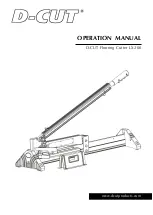
17
GB
Please note that our equipment has not been de-
signed for use in commercial, trade or industrial ap-
plications. Our warranty will be voided if the machine
is used in commercial, trade or industrial businesses
or for equivalent purposes.
5. Safety information
Attention!
The following basic safety measures
must be observed when using electric tools for
protection against electric shock, and the risk of
injury and fire. Read all these notices before using
the electric tool and keep the safety instructions for
later reference.
Store all safety information and instructions for
future reference.
The term “electrical tool” used in the safety instruc-
tions refers to mains-powered electrical tools (with
a mains cable) and battery-powered electrical tools
(without a mains cable).
Safe operation
1 Keep work area clear
- Cluttered areas and benches invite injuries.
2 Consider work area environment
- Do not expose tools to rain.
- Do not use tools in damp or wet locations.
- Keep work area weil lit.
-
Do not use tools in the presence of flamma
-
ble liquids or gases.
3 Guard against electric shock
- Avoid body contact with earthed or ground-
ed surfaces (e.g. pipes, radiators, ranges,
refrigerators).
4 Keep other persons away
- Do not let persons, especially children, not
involved in the work touch the tool or the ex-
tension cord and keep them away from the
work area.
5 Store idle tools
- When not in use, tools should be stored in
a dry locked-up place, out of reach of chil-
dren.
6 Do not force the tool
- lt will do the job better and safer at the rate
for which it was intended.
7 Use the right tool
- Do not force small tools to do the job of a
heavy duty tool.
- Do not use tools for purposes not intended;
or example do not use circular saws to cut
tree limbs or logs.
8 Dress properly
- Do not wear loose clothing or jewellery, they
can be caught in moving parts.
- Non-skid footwear is recommended when
working outdoors.
- Wear protective hair covering to contain
long hair.
9 Use protective equipment
- Use safety glasses.
- Use face or dust mask if working operations
create dust.
10 Connect dust extraction equipment
- lf the tool is provided for the connection of
dust extraction and collecting equipment,
ensure these are connected and properly
used.
- Never yank the cord to disconnect it from
the socket. Keep the cord away from heat,
oil and sharp edges.
11 Secure work
- Where possible use clamps or a vice to hold
the work.
- lt is safer than using your hand.
- For long workpieces, an additional support
(tables, stands, etc.) is required to prevent
the machine from tipping over.
-
Always press the workpiece firmly against
the working plate and stop to prevent the
workpiece from wobbling or twisting.
12 Do not overreach
- Keep proper footing and balance at all
times.
- Avoid awkward hand positions in which one
or both hands could touch the saw blade
due to sudden slipping.
13 Maintain tools with care
- Keep cutting tools sharp and clean for better
and safer performance.
- Follow instruction for lubricating and chang-
ing accessories.
- lnspect tool cords periodically and if dam-
aged have them repaired by an authorized
service facility.
- lnspect extension cords periodically and re-
place if damaged.
- Keep handles dry, clean and free from oil
and grease.
14 Disconnect tools
- When not in use, before servicing and when
changing accessories such as blades, bits
and cutters, disconnect tools from the power
supply.
15 Remove adjusting keys and wrenches
- Form the habit of checking to see that keys
and adjusting wrenches are removed from
the tool before turning it on.
16 Avoid unintentional starting
- Ensure switch is in “off’ position when plug-
ging in.
17 Use outdoor extension leads
- When the tool is used outdoors, use only
extension cords intended for outdoor use
and so marked.
- Only use the cable reel when unrolled.
18 Stay alert
- Watch what you are doing, use common
sense and do not operate the tool when you
are tired.
















































